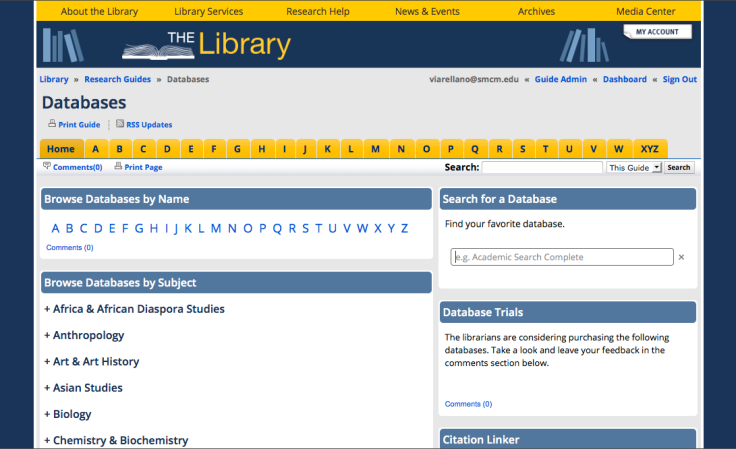Some of my least favorite teaching moments are those focused on mechanics: Click here; scroll there; point at this; type on that space. Jenica Ibarra, Reference & Instruction Librarian at St. Petersburg College-Clearwater Campus uses Canva to get around the mechanical aspects of library instruction to focus on more substantive teaching:
We are, without a doubt, a Springshare library. Libguides? Check! Libanswers? Yes! Libchat? Yup! LibCal? You bet!
Although we’ve embraced Libguides as a platform for creating subject (and not-so-subject-based) guides, we hadn’t really been using Libguides in a way that many librarians currently do: as the main access point to the library’s online database collection. Instead we were using ResearchPort, a gateway maintained by the University of Maryland Libraries ITD center. We wanted to have more control over our database access point interface, so we decided to go with a Libguide. Here’s what I came up with: Databases Libguide (see screenshots below).
It has the same look and feel as our library site and our other libguides, but has some cool features I’m really proud of creating and adapting.
 1. A drop-down Databases by Subject menu
1. A drop-down Databases by Subject menu
The technical support at Springshare is amazing. I knew that I wanted to avoid creating separate pages/tabs for each of our subject categories, but I didn’t know enough about scripting to create collapsible menus. Enter Cindi Trainor at Springshare, who set up a great collapsible box feature for me to use. All that was left for me to do was style each of the subject boxes that that they smooshed together (yes, that’s a technical term) and looked like one giant box. Fooled you, didn’t I?I think this is a nice way to get a lot of useful content on the page without taking up a ton of room. Bonus: Our subject librarians can reuse these database boxes on their own subject guides!
 2. A Find a Database search box
2. A Find a Database search box
This is an adaptation of the search created by Scott Salzman at Furman University Libraries. He recently presented this amazing solution at the 2013 Springy Camp, thereby and was kind enough to offer his code and support.
You can learn more about this search box in the Libguide Scott created for his presentation. It’s a great alternative to using the “search this guide” feature embedded in Libguides, which will only give you the name (aka the letter) of the page in which the database link appears.
3. A space for database trials and our citation linker
If you have questions about the creation of this guide, email Veronica Arellano Douglas.
If your stacks are anything like ours then unused advertising space abounds. Our shelf end-caps have small signs with call number ranges on them and not much else. Theresa Mudrock and her colleagues at the University of Washington Libraries are “experimenting with posters in the stacks to highlight specific databases, subject guides and subject librarians.” It sounds like a fantastic use of dead space.
This poster, created on MS Publisher, promotes our newly acquired module of Oxford Bibliographies. Similar posters were made for other modules including Hinduism, Political Science, etc. The posters were placed in the book stacks in the call number areas for the subject.
It’s a simple but effective marketing technique. Users are already looking for books in a particular subject area, so why not point them to other helpful resources?
For the original Publisher files of these posters, email Theresa Mudrock.
We’re nearing the end of the fiscal year at my library, which means we’re in a mad dash to spend our acquisitions budget. As a result we have a number of different databases on trial at the moment. Each of these slides appears on our library’s website and are meant to draw people in to the database content.
It’s a tricky thing to do. Databases are not often considered “sexy” and unless they’re archival collections with interesting images like the Afro-Americana Imprints, it can be difficult to draw users in to check them out.
I created each slide in hopes that they would catch the eyes of our students and faculty and introduce them to a new resource. I’ll let you know if they work!
For the original Photoshop files, email Veronica Arellano Douglas.
I love call-outs, but I guess you can tell that from this flyer. I find that the mix of screenshots, graphics, and step-by-step text works well with students for database instruction. For the Word document, email April Aultman Becker.










